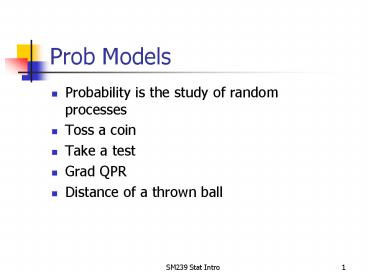Prob Models - PowerPoint PPT Presentation
1 / 18
Title:
Prob Models
Description:
... uses data to draw conclusions about our models. Data is a sample from a population ... We use results from our probability models to measure the uncertainty ... – PowerPoint PPT presentation
Number of Views:59
Avg rating:3.0/5.0
Title: Prob Models
1
Prob Models
- Probability is the study of random processes
- Toss a coin
- Take a test
- Grad QPR
- Distance of a thrown ball
2
Prob Models
- Each individual outcome may vary some
- Still reasonable to describe results
- We have in mind an underlying prob model for the
outcome
3
Prob Models
- Two important models
- 1. Binomial two distinct outcomes
- 2. Normal outcomes on a continuous scale
4
Prob Models
- In most prob models, there are things we do not
know - Free throw percentage
- Avg distance thrown
- Diff between SM121 and SM121A
5
Statistics
- Statistics uses data to draw conclusions about
our models - Data is a sample from a population
- It can be too expensive to gather data on the
entire population - Or we may be trying to predict the future
- Always uncertainty about our conclusions
6
Guessing age
- Tenn. Recently passed a law that salespersons in
liquor stores need to card all customers - Salespersons estimates of customers ages will
vary - Construct a probability model
7
Diff between guess and actual
- Model1 difference between estimated age and
actual age - Might be a normal model, esp if we consider age
as continuous - Want to know if salesperson is right on average
- Want to know how variable salesperson might be
8
Guess correctly?
- Model2 Can salesperson correctly identify
whether or not someone is of legal age? - Binomial model 2 outcomes, either right or
wrong - Want to know probability of being right
- (Not sure how to account for diff between being
right for someone over 21 and being right for
someone under 21.)
9
Types of studies
- Studies can be experiments or observational
studies - Experiments are planned in advance
- Control which subjects are which
- Observational studies are after the fact
10
Experiment
- Experiment for guessing age
- Select photos of subjects of different ages and
have salesperson guess their age
11
Obs study
- Observational study
- In liquor store, have salesperson guess each
customers age - Then compare to ID
12
Limits of observational
- Tricky to draw conclusions from observational
studies - Observe that many people who drive Cadillacs have
gray hair - Does driving a Cadillac cause gray hair?
13
What can stat tell us?
- All of statistics is aimed at answering
scientific questions - How long does it take me to drive to work?
- Is my gas mileage worse when I use the AC?
- Does taking SM121A instead of SM121 improve
students scores? - Does abstinence only sex ed work?
14
SM121A
- Example Does SM121A help?
- Placement into SM121A is based on the math
placement test - Suppose we define a range of borderline scores
that could go either way - We randomly assign some of these to SM121 and
some to SM121A
15
Models
- Binomial consider how many of each group get at
least a C - Compare prob of C between the two groups
- Normal consider score on final exam
- Compare means of scores between the groups
16
Uncertainty
- Any conclusions based on data will have
uncertainty - Two types
- 1. How sure are we that there is some difference?
- 2. How much difference might there be?
17
Uncertainty
- We use results from our probability models to
measure the uncertainty - Suppose that 18 of 20 in SM121 get a C and 19 of
25 in SM121A get a C - If the probability of a C is the same for both
groups, we still might get slightly different s - Answer question 1 by If both groups were the
same, what is the chance of getting what I
observed? - Which means we need to learn to calculate
probabilities
18
General Rule
- Whenever we use statistics, we should be able to
identify the underlying probability model - AND we should be able to relate our conclusions
to something of interest in the scientific
problem

